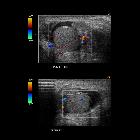Epididymitis






















Epididymitis refers to inflammation of the epididymis and may be associated with inflammation extending to the testis itself, in which case the term epididymo-orchitis is used. This should be distinguished from isolated orchitis, which is by comparison much less common.
Epidemiology
There are two peaks of prevalence: <2 years of age and >6 years of age.
Associations
Clinical presentation
The clinical spectrum ranges from mild tenderness to a severe febrile process with acute unilateral scrotal pain.
Pathology
The infection usually originates in the bladder or prostate gland spreads through the ductus deferens and the lymphatics of the spermatic cord to the epididymis, and finally reaches the testis, causing epididymo-orchitis. Due to this progression, infection starts in the tail of the epididymis.
Radiographic features
Ultrasound
The epididymal tail is the most affected region, and reactive hydrocele and scrotal wall thickening are frequently present. As the infection spreads, it can ascend the body and later the head of the epididymis.
Increased size and, depending on the time of evolution, decreased, increased, or heterogeneous echogenicity of the affected organ are usually observed.
The inflammation produces increased blood flow within the epididymis, testis, or both. Pulsed wave Doppler interrogation yielding an epididymal peak systolic velocity (PSV) greater than 15 cm/sec is highly suggestive of epididymitis, especially when the PSV on the affected side is significantly higher than the unaffected (with a ratio > 1.7) .
Analysis of the epididymal waveform may reveal a low-resistance pattern as compared with the normal pattern; a resistive index (RI) < 0.5 is frequently present .
Nuclear medicine
Pertechnetate scintigraphy can be used in evaluating acute scrotum. Increased perfusion and uptake of the scrotal contents are characteristic of epididymo-orchitis. In isolated epididymitis increased curvilinear activity is seen laterally, corresponding to the inflamed epididymis.
Treatment and prognosis
The vast majority of patients are managed with simple analgesia and oral antibiotics.
Complications
Complications of epididymo-orchitis include:
- vascular compromise due to increased intratesticular pressure resulting in testicular ischemia, and even infarction
- epididymal abscess
- testicular abscess
Differential diagnosis
Differential considerations include
- isolated orchitis
- granulomatous epididymitis
- chronic epididymitis: enlarged epididymis with increased heterogeneous echogenicity
- testicular neoplasm: clinical presentation is usually different
Siehe auch:
und weiter:

 Assoziationen und Differentialdiagnosen zu Epididymitis:
Assoziationen und Differentialdiagnosen zu Epididymitis:




